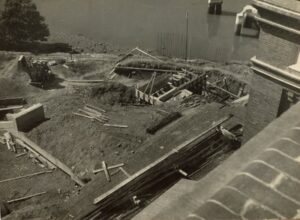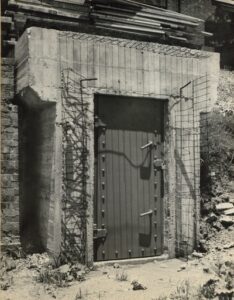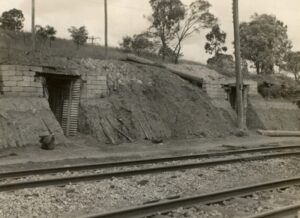1940’s Electric Memories
1940: Goomeri gets electricity
The town of Goomeri in Kilkivan Shire received its electricity supply from the Murgon Powerhouse on 2 May, 1940. It had taken twelve years of negotiations and construction of lines to finalise the scheme and it was planned to be the start of other connections. Following the usual official dinner, the speeches and the Switch-on Ceremony, the happy crowd was rewarded with strings of colourful lights and bunting everywhere. There was a troupe of Minstrels, a decorated truck, music and cheerful songs. A few speeches were necessary to solemnise the occasion and one of the speakers, Mr. Cochran, Chairman of the State Electricity Commission, who had turned on the lights, mentioned that now electricity was available, it was everyone’s duty to put it to the fullest use. This comment was present in at least one of the speeches at all switch-on ceremonies. It cost a great deal of expense to take lines to the small towns in rural areas and encouragement to use as much electricity as possible was the general view from the electricity supply industry.




1945/1946: Regional Authorities Act
The Regional Electric Authorities Act of 1945 was created to establish regional electricity boards to cover the majority of Queensland. The legislation was based on the plans for Central Generating Stations to be constructed at Howard, Rockhampton and Townsville. South East Queensland retained the City Electric Light Company (CEL) as the main electricity authority for the non-metropolitan areas and the Toowoomba Electric Light Company (TELCo), which covered the city of Toowoomba and the Darling Downs area, remained in existence to expand its rural electrification programme. The Capricornia Regional Electricity Board (CREB) and the Townsville Regional Electricity Board (TREB) were constituted in1946. To assist with regional growth plans, in the same year, SEC had its powers extended by the Government with amendments to the State Electricity Commission Act to acquire existing power stations, build new ones, borrow money, organise amalgamations and set prices.
1946: Cherbourg
The town of Cherbourg also received its electricity supply from the Murgon Powerhouse since its Switch-on Ceremony took place on 22 November, 1946.
1945-49 Toowoomba Electric Light Company (TELCo)
The period from 1945 to1947 witnessed some rapid developments in the TELCo area. During 1946, TELCo acquired the electricity undertaking of Stanthorpe Shire Council. The construction of a transmission line from Warwick to Stanthorpe was planned so that TELCo could continue to operate the generating plant in Stanthorpe’s Powerhouse, which had received supplementary plant from the Warwick Powerhouse to meet extra loading in the area. The Killarney Powerhouse was closed in December 1946 and a high-tension transmission line between Warwick and Killarney was energised to enable rural areas between those towns ‘to enjoy the benefits of electricity’. By 1947, the extended TELCo area of supply totalled 9,324 square miles and State Electricity Commission’s plans for the extensive electrification of the Darling Downs were progressing successfully.
The 11kV transmission line from Pittsworth to Millmerran and the low-tension reticulation to that town was completed and supply made available to Millmerran on 28 November 1947 in time for Christmas. A section of the Warwick to Stanthorpe transmission line also came into service that year and supplied Thulimbah and the Summit. During 1947, ‘a total of 705 consumers were added to the distribution system’ making 14,601 altogether, which resulted in an increase in kilowatt hours of almost 25 per cent when compared to the previous year.
During the late 1940s, the changeover from Direct Current (DC) to Alternating Current (AC) was taking place. In Warwick, DC had almost been eliminated from the city. Progress was continuing in Toowoomba, although a large part of the city still had a DC supply partly due to a shortage of AC meters. Regardless of the limitations, during the twelve month period from 1949 to 1950, 396 premises were changed over to AC supply and an additional 440 by 1951. The final changeover from DC to AC was not complete in the Toowoomba district until the rotary converters were used for the last time on 9 August 1958.
In late 1948 and early 1949, further lines from Oakey were constructed and energised, which brought supply to Acland in December 1948 and Goombungee in April 1949. Further 11kV extensions from Acland to Balgowan and Sugarloaf were progressing to allow the electrification of the Balgowan, Sugarloaf and Willeroo coalmines. Work had also started on extensions on the Warwick Road to open up the rich dairying district for supply.
1948
In 1948, the Nanango Butter Factory ceased to produce electricity for the town. Supply was extended to Nanango from Kingaroy Powerhouse until Howard Power Station was commissioned and Kingaroy Powerhouse closed down.
